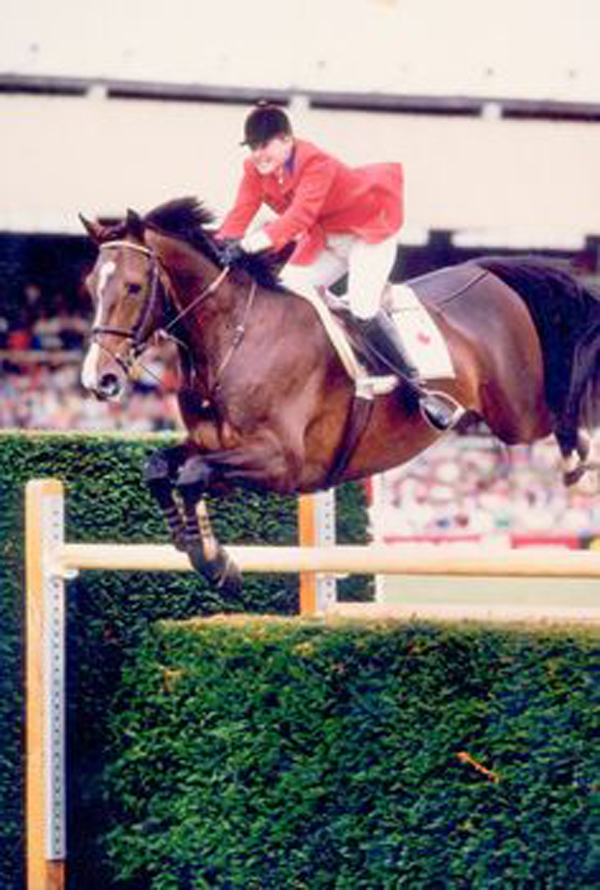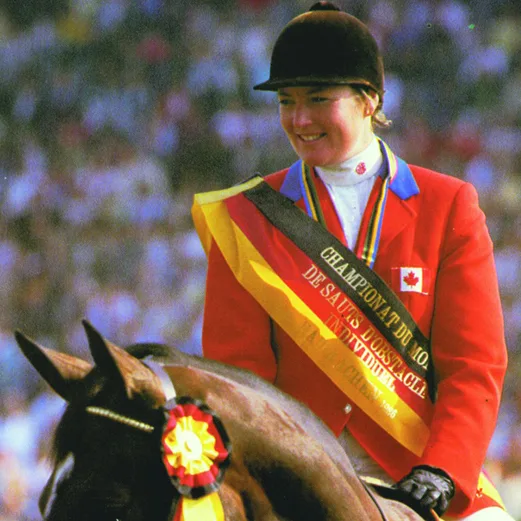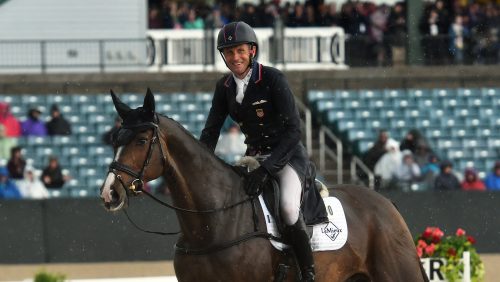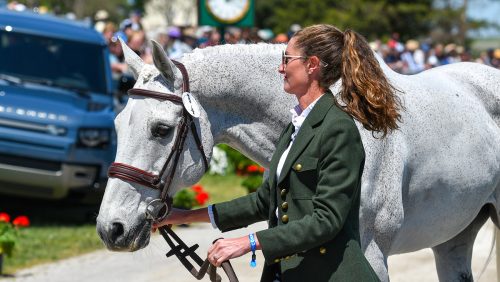Thirty years ago, on the world’s biggest stage of show jumping, a relative unknown snagged the individual gold medal in the World Championships in a result that thrilled the world.
In her first appearance in an international team championship, Canadian Gail Greenough headed into the final four up against individual Olympic silver medalist Conrad Homfeld, French star Pierre Durand and British legend Nick Skelton.
She was the first woman to ride in the final four for individual medals at the World Championship. “It was unusual because in that era, women weren’t usually in the final four, and there hadn’t been a female world champion. So they didn’t really take me too seriously. The odds were against me,” Greenough remembered.
“It was a life-changing week for me. It remains fresh, even though it was 30 years ago!”
Greenough, 26, was the obvious choice for the Canadian team after she and Mr. T won two of the Canadian selection trials and placed second in the third. They headed to the iconic Aachen showgrounds in Germany for the World Championships with teammates Ian Millar, Laura Tidball-Balisky and John Anderson.
“I had a very good horse in Mr. T. Even in today’s game, he’d still be a very good horse. He was one in a million,” said Greenough. “It’s all about peaking at the right time, and he was on that track. So, although I was an underdog, I felt pretty confident going into the week.
“I wasn’t intimidated because I grew up riding at Spruce Meadows, so I rode against all those guys almost every year there growing up. I think that was the biggest reason I was pretty comfortable at Aachen. You’re so focused at that point that you don’t really look at the end of the week. You just take one jump at a time, one line at a time, one course at a time. I wanted to do well for the team and see where the chips fell after that. But to think that I was going to win at the end of it wasn’t really in my thoughts at all.”

But after the Canadian team finished a close fourth, Greenough and Mr. T were in the top four in the individual standings and headed to the final four, where the top four riders would jump a round on each horse—their horse first and then the three other horses.
“Going into the final four, I have to say I was a little more nervous,” Greenough said. “But what I did is I broke it down. I watched a lot of video of each horse beforehand, and I tried to liken each horse to a horse I’d ridden in my career. So I wanted to take away some of the unknowns. It really paid off and worked well.”
Greenough rode her own mount, Mr. T, over the course first:
ADVERTISEMENT
“He was a real character. He had a lot of personality. He was cheeky for sure,” Greenough said. “He was so used to just me, and he was a little bit tricky in that he had a little more blood than he let on watching him.” Mr. T was just 9 at the time.
“I thought his emotional temperature would go up, and I didn’t think he’d be too easy for everybody else. He appeared easy to watch—it was just this little girl riding, and he was fine,” Greenough continued. “So I think the riders were surprised that he had as much blood as he did and that his temperament changed quite a bit for each rider.”
Greenough said it was nerve-wracking watching the others ride him. “It’s a strange feeling, because you hope it goes well, but you also hope it doesn’t go well!” she said. “You have conflicting emotions about it.”
The riders didn’t share too much information about their mounts with each other, but Greenough made sure to warn Skelton about a possible issue. “I talked to Nick a little bit about T because the way Nick’s release works wasn’t going to be something that T would like,” she said. “The way Nick used his hand three strides out, I knew was going to be a problem for T, because he was going to feel abandoned.”
Skelton did run into trouble with T, as the gelding trotted into and then stopped at the triple combination.
“We wished each other good luck, and off we went,” Greenough said.
Greenough’s next ride was Abdullah:
“He was amazing! I loved that horse. He was so beautifully broke,” Greenough said. “You have a few minutes to warm up, and you can jump two jumps, and I enjoyed that part of it so much on him because he was so lovely to ride. I was doing flying changes across the diagonal—it felt like I was on an equitation horse. His jump was very easy, very fluid. Conrad did such a beautiful job on him.”
Then Greenough faced her toughest challenge, Skelton’s Apollo:
“He was a big, strong horse,” she recalled. “In my warm-up with Apollo, I just didn’t want to get too out of control. I didn’t want to pick up a gallop in case I couldn’t stop him—which I probably couldn’t!
ADVERTISEMENT
“So I didn’t pick any fights with him, and I was very tactful. I tried to let him just go along and not get his blood up at all, hoping that would carry me through in the round, and we could leave the jumps up,” she said. “Out of all the horses, I don’t know that I could duplicate that round on Apollo. Even Nick said, when he was asked who he thought would be the hardest horse, he said, ‘Probably my own.’ He was a powerful jumper, but a bit of a trick to ride.”
Then, Greenough got a leg up onto Jappeloup De Luze—a 15.2-hand fireball. She’d jumped three clean rounds and was in the lead. The German crowd, lacking a German rider to cheer on, had adopted Greenough and roared in approval:
“I liked Jappeloup the best! He was a type of horse that I was used to,” Greenough said. “I grew up riding horses with a lot of blood, so for me, it was really fun. He caught me a little off guard in the first jump of the round—he rocketed off the ground, and I landed in a bit of heap. I had to tell myself to stay down in my heel and up with my head a little more!
“After that I got my heels down and my head up, and things went better. But he had such power off the ground.”
With a clear round on each horse, Greenough had emerged on top of the world. “It was a feeling of complete elation. It’s a bit surreal at the time, for sure. You can’t quite comprehend,” she said.
“You’re still kind of in the moment of riding the horse and concentrating, and then all of a sudden it’s all over and you’ve won. It’s surreal, at that moment. It takes a while for things like that to sink in. If you ask anybody who’s won at the top level—it’s instant elation, but the repercussions took a while to sink in.
Greenough was feted around the world and celebrated as a celebrity in Canada. “There were so many different honors and awards, keys to cities. I was awarded the Order of Canada, so many wonderful accolades afterwards,” she said. “And you have to make time in your schedule for all of that! It takes away from the daily grind of riding and everything else you need to do. It was a change in my daily life for a while, that way, for sure.”
At the time, news of a relative unknown on the international stage, and a female at that, was huge. “There were only a few of us women riding at the top level, and most of them were Americans,” Greenough said. “So in Europe, it was all male-dominated. It was a shock for a lot of people for a woman to win, I think.
“What’s still for me, even a bigger surprise than that, is that I’m still the only female and still the only North American to have won that individual gold,” she continued. “That’s an even bigger shock for me, that 30 years later that record still stands. There have been so many amazing women and North American athletes, but it hasn’t happened.”
Greenough and Mr. T returned to Europe in the fall of ’86 and won the Grand Prix of Stuttgart (Germany). But then T had a series of injuries that took him out of the ring. “He went back and forth between trying to make a comeback and recovering. Then he got sick and ended up having cancer in his intestines,” Greenough said. “We ended up having to put him down, and it was a very sad time for me. He was 14. He had some success after those Games, but his longevity wasn’t quite what we thought it would be.”
Greenough took a break from showing at the top level in 1992, focusing on commentating for CBC Sports and serving as a selector for the Canadian team. A special horse, Lesandra, brought her back to the grand prix ring in 2001, and she qualified to represent Canada on the ’03 Pan American Games team. “She tweaked a suspensory just before, so we didn’t go,” Greenough said. “Then I got more into the coaching end of it. I ran quite a big business in Calgary for a number of years and took teams to Young Riders, had a student win the CET Medal at the Royal. I did a lot of clinics around the world. I got more into the business end of it, developing young horses, teaching and sourcing horses internationally.”















